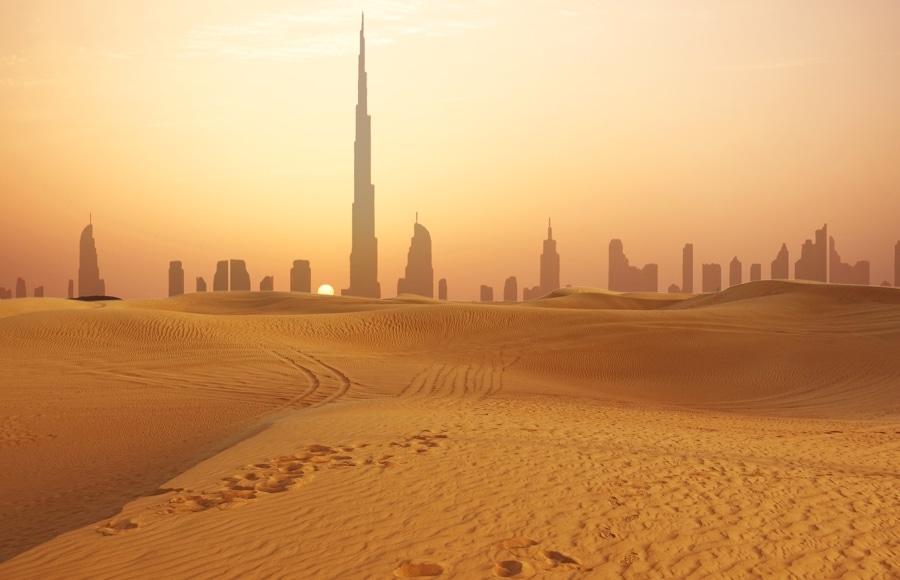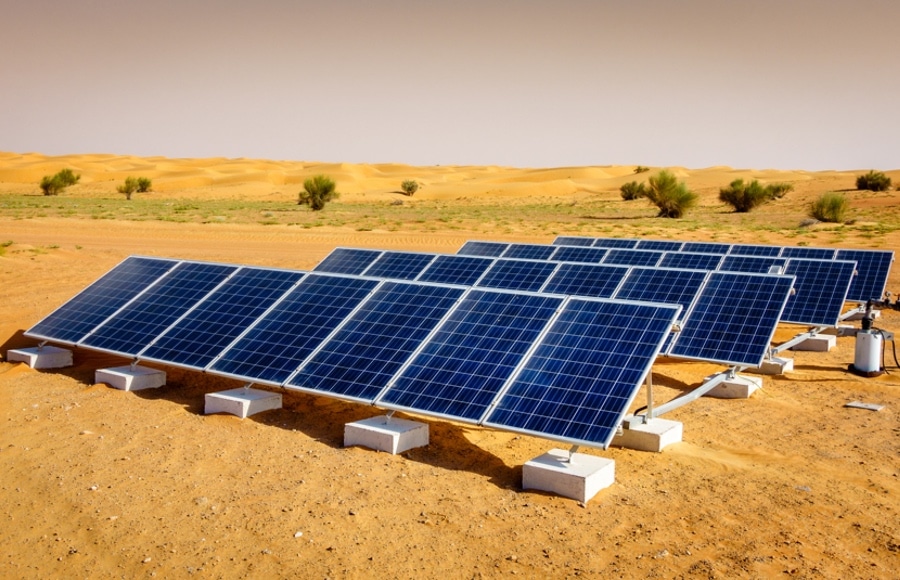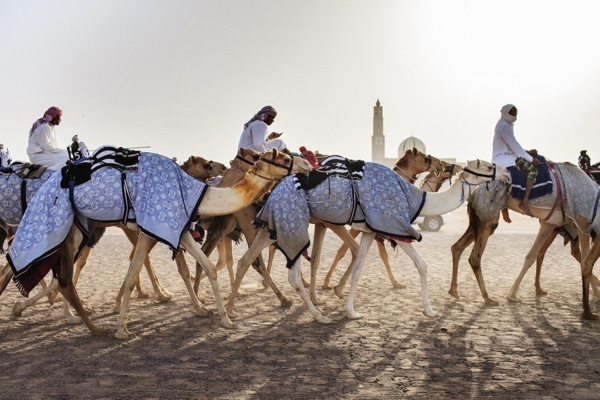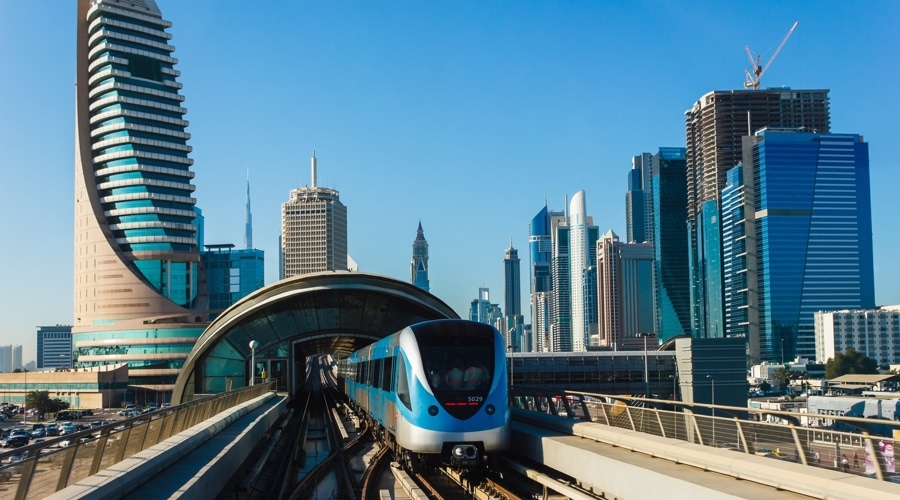Climate of Dubai
Dubai, located in the United Arab Emirates, is defined by a subtropical desert climate and high average temperature. Due to its proximity with the Tropic of Cancer and the Northern desert belt, winters are quite warm and summers can be very hot.
Dubai average temperature by month
Dubai has 2 different seasons: winter and summer.
During winter months the weather is warm. Even if it is the peak tourist season, winter is still the most comfortable period to visit the city of Dubai because of the air and water temperature. At the coldest time of the year, temperatures vary from 14 °C to 25 °C in January.
During summer months the temperature is very high. The hottest temperature recorded in Dubai was 49°C in August. In summer, the weather in Dubai can be also very humid. It is not very convenient for visiting but Dubai has a lot of climatized areas. We recommend you to do indoor activities in the afternoon.
If you like to go shopping or you are simply curious, visit the second-largest shopping center in the world: The Dubai Mall. After the sunset, when temperatures decrease we recommend you to enjoy the Dubai Fountain Show near The Dubai Mall.
You can visit the Burj Khalifa for a breathtaking view. All the observation decks are climatized all year round. The building measures 828 meters in total. You will be able to see all the city and some islands as well.
To stay fresh in the afternoon you could explore one of the largest aquariums in the world: the Dubai aquarium. It contains 10 millions liters of water and a lot of deep-sea species. If you are quite adventurous you can try the attraction “diving with sharks”.
Waterpark Wild Wali can be a great idea to escape the heat especially if you are traveling with children. It is composed of 24 attractions on the theme of the tale of Juha, a famous character in the Arabian folklore.
| Month | January | February | March | April | May | June |
|---|---|---|---|---|---|---|
| Max°C | 25 | 37 | 31 | 36 | 41 | 44 |
| Min°C | 14 | 14 | 17 | 20 | 22 | 24 |
| Month | July | August | September | October | November | December |
|---|---|---|---|---|---|---|
| Max°C | 45 | 45 | 42 | 37 | 32 | 27 |
| Min°C | 26 | 26 | 24 | 21 | 18 | 15 |
Dubai precipitation by month
| Month | January | February | March | April | May | June |
|---|---|---|---|---|---|---|
| Prec.(mm) | 10 | 35 | 25 | 10 | 1 | 0 |
| Prec.(in) | 0,4 | 1,4 | 1 | 0,4 | 0 | 0 |
| Days | 2 | 4 | 4 | 2 | 0 | 0 |
| Month | July | August | September | October | November | December |
|---|---|---|---|---|---|---|
| Prec.(mm) | 0 | 0 | 0 | 0 | 2 | 15 |
| Prec.(in) | 0 | 0 | 0 | 0 | 0,1 | 0,6 |
| Days | 0 | 0 | 0 | 0 | 0 | 6 |
Precipitation in Dubai is very low. Rainfall is brief but intense and occurs between December and April. February is the wettest month of the year with 35 mm of precipitation but temperatures are warm. Humidity can be quite important especially in February with a humidity level of 60 percent.
However, 2019 Dubai has seen almost two weeks of rain in a short time period. This high level of precipitation caused traffic disruptions. This phenomenon can be the result of the cloud seeding program according to the National Centre of Meteorology.
In early 2000, UAE started thinking about cloud seeding to resolve the lack of water problem. The process consists of increasing the rainfall from the cloud by pulverizing a salted substance. The rainfall has been increased by 30 percent.
Dubai winds and sandstorm
Dubai is often affected by a northwesterly wind, also known as Shamal who comes from the Arabian desert. This wind brings a lot of sand to the city of Dubai.
The first major shamal of the year comes around May 26, according to folklore. Inhabitants of the region named it "Al-Haffar" or "driller".
The second one arriving in early June is called Barih Thorayya because of the dawn star of the Pleiades. At this time of the year, shamal can be very violent. Fishermen used to stay at home because they believed that this wind, in particular, devours ships. The last big shamal usually appears at the end of June and it is known as the Al-Dabaran or the follower.
This wind can create sandstorms that can last for days in summer months. It is frequent that the UAE is trapped in a sandstorm that affect air quality.
According to a report by Emirates Wildlife Society-WWF published in 2017, the number of a sandstorm will consequently increase because of global warming. The most extreme sandstorms are commonly observed in Saudi Arabia, Kuwait and Iraq.

Dubai sea temperature
The sea temperature in Dubai is warm the entire year. The lowest water temperature is 23 °C from January to March. From June to October sea temperature exceeds 30 °C. The Persian Gulf is known to be one of the warmest seas in the world in summer. Dubai is a good city to stay if you want to swim all year long.
We recommend you to go to Jumeirah Beach to enjoy the nice white sand and warm water. If you want to experience something more adventurous, try a jet ski tour on the Arabian sea.
Best time to go to Dubai
The best time to visit Dubai is from November to March. However, be prepared to face crowds because of the peak tourist season. From april to October it can be very hot and inconvenient for the travellers who don’t want to stay all day long in the climatized area.
If you want to swim and to do sunbathing, we recommend you to come in March or November. To observe a magical sunset during the winter months, when days are shorter, go to visit "At The Top" in the Burj Khalifa.
Learn more about the weather in Dubai by month: November, December and January.
Arabian desert weather
If you are visiting the sunny city of Dubai, you certainly want to discover the part of the Arabian desert located in the UAE. It has a subtropical, hot desert climate. The weather there is hot and dry with a lot of sunshine. The sunshine duration is between 2,900 hours and 3,600 hours. However, dust and humidity can reduce visibility.
The average temperature is over 40°C and it can reach up to 48°C in summer. In winter, night temperature drops to 5°C. The average rainfall amount is around 100 mm. Winds are frequent in the Arabian Desert and they transport a lot of desert sand to the city of Dubai.
If you want to experience the desert you can go to the Rub-al-Khali, also known as Dubai desert. There you have a choice between plenty of activity such as camel riding, quad bike, car safari. Do you want to have more fun? Try sandboarding on the red dunes. At night we recommend you an unforgettable experience of Arabian dinner in in a desert camp.

Climate change in Dubai
Dubai will have to face some challenges in the future: sur-exploitation of natural resources, population growth, high energy demand, global warming. The United Arab Emirates invest for a long time in renewable energy infrastructure like solar PV.
However loss of the wildlife, urbanization, lake of water and sea level rise are still a major problem. We can see that global warming has a huge impact on this part of the planet.

The rising sea level will cause a lot of troubles because of all the buildings on the cost. According to The Abu Dhabi Environmental Agency, 85 percent of the UAE’s population will be affected by this. Concerning the lack of agricultural lands, the United Arab Emirates imports a lot of food from India.
In December 2015 at the COP21, UAE expresses they will produce 24 percent of its energy from sustainable sources by 2021. In September 2016, UAE was the first country to support the Paris Agreement. Research, studies, and partnership with the private sector are encouraged by the UAE Council for Climate Change and Environment.




